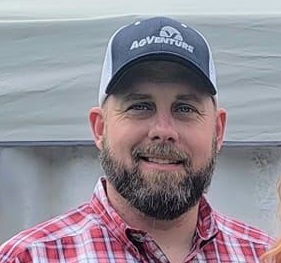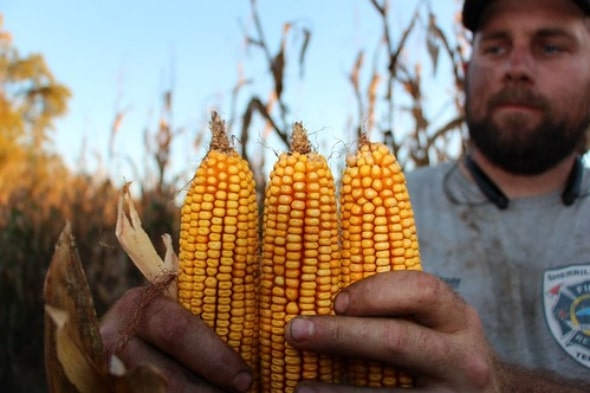
First-generation farmer Russell Hedrick is no stranger to taking the road less traveled when it comes to farming. The former fireman-turned-farmer has been growing corn and soybeans on his 30-acre farm in Hickory, North Carolina, for the past ten years. And he’s reaped the benefits of utilizing regenerative agriculture practices and technologies that not only provide a positive return-on-investment (ROI) for his soil health, but also for his farm’s bottom line.
Russell Hedrick (RH): “Our goal is to increase farm ground to where it produces better products, healthier products and reduces our impact on the environment.”
Hedrick initially began using cover crops as a defense mechanism for winter erosion and winter weeds. He learned about nutrient cycling and soil biology, plugging away on his fields. Over the years, he worked to increase the percentage of organic matter that kept the soil in his fields while also boosting its health and resilience, which, in turn, rewarded Hedrick in a way he didn’t anticipate.
RH: “Coming into 2022, the top six inches of topsoil was averaging 8 1/2 % organic matter and the six to 12 inches below, that was averaging 6 1/2% organic matter. What a lot of farmers don’t understand is if you get rain and you don’t have a vessel to store it in, then what good was the rain in the first place?”
By increasing the percentage of organic matter in his fields, Hedrick essentially created a reservoir to keep his crops healthy and, as a result, increase his yield. So much so that, in 2022, Hedrick earned a new world record from the North Carolina Corn Growers Yield with 459.1 bushels per acre. He credits his success to the use of regenerative agriculture practices – specifically no-till and cover crops – to build soil biology and a critical eye on what his crops need and when they need it.

RH: “We spoon feed crops. We don’t dump on a ton of nutrients. We make multiple passes at certain times.”
He does this to help the plants thrive. Hedrick points out that flooding plants with nutrients only makes them want to use up what they’ve got as quickly as possible regardless of the amount of rainfall or grow conditions.
RH: “The way we look at it, it costs us about $9 to make an additional pass over the farm. Most of our corn sees at least one extra over-the-top pass, too, which allows us to stop denitrification, or leaching, because our ground isn’t able to keep the nitrogen close if you throw it all on.”
By monitoring rainfall and determining the best time for nitrogen application, Hedrick says, “[It] keeps everything in a concentrated zone within the roots and it allows the plant to use it when it needs it.”

Soil management + regenerative practices = ROI
According to Hedrick, one of the biggest issues in American agriculture is the lack of farmers completing their own agronomy work. Many farms outsource this part of the operation and, instead, concentrate on managing the timing of inputs or daily farm tasks. However, Hedrick says understanding the science of soil management and crop production is critical in boosting a farm’s profitability.
RH: “The biggest return-on-investment (ROI) that we’ve seen on the farm is us doing our own fertility rates and mapping that against other farmers’ fertility rates.”
Hedrick uses the Haney Test, which was developed by Dr. Rick Haney, a research soil scientist at the USDA. It is a dual extraction test that analyzes a soil sample for total organic carbon and total organic nitrogen to figure out a C:N ration to determine what cover crop works best for that area.
RH: “As a first-generation farmer, why would I use outdated technologies when, you know, I’ve only been farming ten years and the technology has changed leaps and bounds.”
Hedrick has used historic soil tests, which he thinks gives farmers a false sense of security by showing more nutrients available than what is actually in the ground. The Haney Test, on the other hand, uses water and root exudates that give clear results for soil management decisions.
Hedrick has used historic soil tests, which he thinks gives farmers a false sense of security by showing more nutrients available than what is actually in the ground. The Haney Test, on the other hand, uses water and root exudates that give clear results for soil management decisions.

And Hedrick believes it works – the savings on his land are proof.
RH: “In 2022, on nitrogen, potassium and phosphorus, we saved $164,000 using the Haney Test. How many farmers are talking about going broke from fertilizer prices last year? And there’s producers that are bigger than our operation that could have been saving even more money than that.”
Soil Regen: a farmer-to-farmer educational platform
RH: “One of the reasons I’ve been so successful is I give a ton of credit to all the people who were doing this before me that took the time to talk on the phone or answer emails or talk to me at a conference. Sharing successes and failures helps the people after you gain better results faster.”
He points to the Godfather of Soil Health, David Brandt, who was using regenerative agriculture practices for the last 40 years before anyone else. Talking with Brandt gave Hedrick a starting point, a way to compare where he was and where he wanted to go. He wanted to make that level of accessibility, of improving and learning from prior generational knowledge, available to the farmers who wanted it. Enter Soil Regen, which Hedrick co-founded with Liz Haney, a soil and ecosystem scientist.
Soil Regen serves as a farmer-to-farmer link between implementing regenerative agriculture practices on the farm and sharing how to make those practices profitable and high yielding. They do this through conferences like the Big Soil Health Event and one-on-one conversations with Hedrick and the other 17 farmers on their team who can talk farm plans, make on-farm visits and, generally, increase the network of growers. It’s about providing resources to those already involved with regenerative agriculture practices and to those interested in beginning.
Hedrick likens it to a community. “I call it a community of farmers,” he says. “We all want to see each other succeed and be profitable. The biggest thing we focus on is really the return on investment of your farm and, really, the quality of life.”
#regenerativeagriculture #farmmanagment
